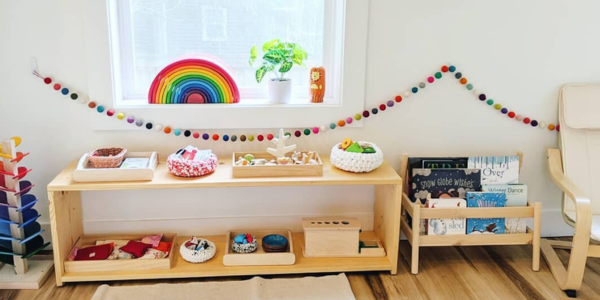Creating a Montessori-inspired space at home for young children is all about designing an environment that fosters independence, curiosity, and a love for learning. Here are some tips on what to include:
1. Keep Everything Child-Sized
- Furniture: Use child-sized tables, chairs, and shelves so that everything is within reach. Low shelves encourage independence by allowing children to choose activities on their own.
- Accessible Tools: Ensure that everyday items like dishes, cups, and cleaning tools are accessible for your child.
2. Create a Sense of Order
- Organised Shelving: Use open shelving to display toys, books, and learning materials neatly. Store each item in baskets or trays, and have only a few options available to prevent overwhelming your child.
- Declutter: Montessori spaces are minimal and uncluttered. Fewer items allow for more focus and intentional play.
3. Use Natural Materials
- Montessori environments favour materials made from wood, metal, cotton, and other natural elements. These materials provide a better sensory experience and connect children to nature.
- Avoid Plastic Toys: Instead, opt for wooden toys, real plants, or sensory baskets filled with materials like pinecones, stones, or wool.
4. Create Activity Stations
- Practical Life Area: Set up areas where your child can practice everyday tasks such as pouring water, preparing snacks, or sweeping. Provide real (child-friendly) tools like a small broom or kitchen utensils.
- Creative Station: Offer art supplies (like crayons, paper, scissors) in a neat, accessible area. Encourage free expression but keep it organised.
5. Encourage Movement
- Montessori classrooms value freedom of movement, and you can do the same at home. Design the space so your child can move freely between activities.
- Floor Mats: Use a small rug or mat where your child can sit, play, or explore different activities comfortably.
6. Provide Age-Appropriate Learning Materials
- Use Montessori-inspired learning materials that encourage exploration and skill development. These can be puzzles, building blocks, or sorting trays for younger children. Make sure they are suited to your child’s age and developmental stage.
- Rotate toys and activities regularly to keep things fresh.
7. Create a Reading Nook
- Low Bookshelves: Place books at your child’s eye level so they can easily choose their favourites.
- Cozy Spot: Set up a comfy reading area with cushions or a child-sized chair to create a calm, inviting space for reading.
8. Encourage Independence
- In every part of your home, create ways for your child to do things independently. For example:
- Clothing: Use low hooks for coats or easy-to-reach drawers for clothes.
- Bathroom: Provide a step stool for handwashing and brushing teeth.
9. Keep the Space Calm and Simple
- Use neutral or calming colors on walls and furniture to create a peaceful atmosphere. Avoid bright, overstimulating colours or too many decorative elements.
- Natural Light: Ensure the space is well-lit with natural light whenever possible, as it supports a calm and focused environment.
10. Encourage Care of the Environment
- Create opportunities for your child to learn about taking care of their space. Provide child-friendly cleaning supplies like small sponges or dusters so they can help clean up.
By creating a space that is organised, accessible, and aligned with your child’s needs, you will foster independence, curiosity, and a love for learning, just like in a Montessori environment.
Here is another great article with picture examples of creating a Montessori-led home environment.
Image Copyright https://www.montessoriinreallife.com/
